This is a Veteran Owned site

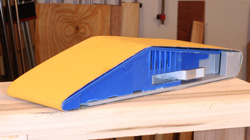 |
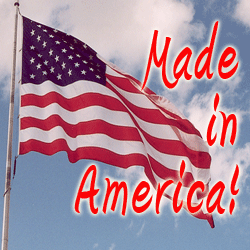 |
The Sharkee Sander™ looks kind of racy and it is kind of fast but it it that shape and some common sense that make it a better sanding block! And, it is Made in America! Click image to enlarge |
|
Sharkee Sander™
A nice improvement on an old idea
Text, photos and video by Tom Hintz
Posted – 11-9-2011
Sanding blocks are an old idea. Sanding blocks that use existing sanding belt sizes is also not a new idea. However, the Sharkee Sander™ takes those ideas to a new level with some thoughtful shaping of the underlying sanding block. The Sharkee Sander™ also makes sense in what it does not have. If you need another fact on the plus side, the Sharkee Sander™ is Made in America!
Clearer Thinking
I have used store-bought sanding blocks for decades but always had one or two shop-built versions lying around though I just wrapped sheet sandpaper around those. The only reason I made my own sanding blocks was because the factory-made ones usually had some kind of foam pad beneath the sanding belt on the primary sanding surface. That foam pad might sound like a good idea but it has at least one detrimental property in the woodworking shop.
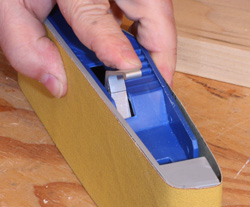 |
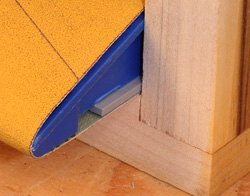 |
Changing the belt on the Sharkee Sander™means flipping this lever. (left) It actually releases the belt for easy removal or installation! By laying the Sharkee Sander™ on its side when you install the belt, it automatically aligns with the 3"-wide body so you can sand right up to vertical obstructions (right) and tight into corners! Click images to enlarge |
|
One thing the foam pad did was prevent the sanding block from removing small variances in height on a surface quickly. I could live with that but if you tried to sand an outside surface of anything resembling a box, that foam pad let the abrasive to spring below the surface a bit when you sanded off the edge and insured that the corner would develop a slightly rounded or tapered edge. If I used my store-bought sanding block at all I would change to my hard-soled shop-made versions to sand near the edge so that kept its crisp line. The Sharkee Sander™ does not have the foam pad which in my estimation is a good feature to not have.
Getting Belted
The Sharkee Sander™ uses the hyper-popular 3” by 21” sanding belts. That means that you can find them just about anywhere hardware or home supplies are sold. That popularity also lets you choose from the widest variety of grits and abrasive types. If you have a 3” by 21” belt sander you will find that when the belts seem to lose their cutting ability on the powered sander they work very well on the Sharkee Sander™.
Because the body of the Sharkee Sander™ is also 3”-wide getting the belt in place is easy. The lever that releases the belt actually does release the belt fully, not just a little which can force you to work it off of the block. With the Sharkee Sander™ you flip the tension lever open and the belt slides right off or onto the block. Set the Sharkee Sander™ on its side and you can slip the belt in place, flip the lever to the tension position and the belt is ready to use and perfectly aligned with the edges of the block.
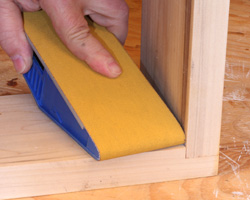 |
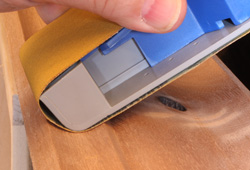 |
The long sloping nose (left) makes it easy to sand into obstructed areas. The back end of the Sharkee Sander™ has a 90-degree edge on top and this large radius (right) that makes smoothing many shapes much easier. Click images to enlarge |
|
Shapely
The Sharkee Sander™ also features a long, tapered surface that gives you easy access to lots of semi-obstructed surfaces. Most off-the-shelf sanding blocks do have 90-degree corners and perhaps even a rounded edge or two but the long sloped end of the Sharkee Sander™ is the first I have seen. Certainly this is not a surface that you will use every day but when you need to reach into an obstructed area to do some sanding the Sharkee Sander™ will make your day.
In fact, both upper surfaces are sloped away from each other which fits the hand better and produces a “high-pressure” ridge where those surfaces meet. Flip the Sharkee Sander™ over and that ridge lets you apply a bunch of force to concentrate sanding power on that one spot. This will come in handy when you come across a spot of glue or some other blemish that requires aggressive sanding to eliminate.
The lower back edge is rounded and the upper corner at the rear is square and 90-degrees. The front edge is also rounded but with a much smaller radius. The gist of all these surfaces and how they meet means that the Sharkee Sander™ will be more useful in more places than other commercial sanding blocks that I have used or seen.
In the Shop
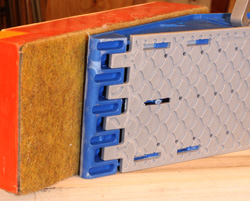 |
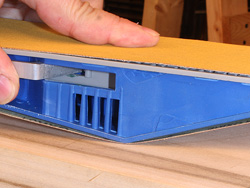 |
Where most sanding blocks have a soft pad on the bottom the Sharkee Sander™ has a flat and solid surface (left) that lets you sand over the edges of a box without rounding the edges! The dual slope on the top of the Sharkee Sander™ offer this ridge (right) that lets you apply tremendous force to tough spots that resist sanding any other way. Click images to enlarge |
|
I wouldn’t have thought that using one sanding block would be much different from any other but the Sharkee Sander™ is different. Not having the soft pad on the bottom seems to make the abrasive a little more aggressive. That effect is most noticeable when you encounter small high spots that need to be flattened. The flat but hard bottom surface on the Sharkee Sander™ doesn’t give when you run over those spots so more sanding force is applied to the irregularities. The result is that you get a flatter surface quicker which I like a bunch seeing as how I don’t enjoy sanding even a little bit.
The overall shape of the Sharkee Sander™ also makes it easier to use in more places. The long sloped nose is really nice in confined areas. The length of that sloped surface lets you reach farther into an obstructed space which saves time and lets you get a consistently smooth surface in places than would have been possible with mere mortal sanding blocks.
The Sharkee Sander™ is surprisingly comfortable to the hand. Because the body and sanding belt are the same width sanding inside edges is very easy and effective. It is also easy to use in odd places where my old, store-bought sanding blocks just did not work well if at all. The tapered front end of the Sharkee Sander™ really is nice and whether you use it right side up or upside down, that sloped surface is easy to use. Using the upper ridge to bear down on a tough spot is also very easy.
One of the big things to me is that solid bottom surface that sands edges without rounding. As I learned woodworking and did less stupid stuff myself I began to notice things like the rounded edges on my boxes left by more traditional sanding block designs. The Sharkee Sander™ sands these surfaces very well and leaves the straight, crisp line that makes the whole project look better.
Conclusions
Video Tour |
The Sharkee Sander™ is well made, American Made and designed to function well in a wide range of situations from auto body to woodworking. With a street price of just $15.99 each (11-9-2011) the Sharkee Sander™ isn’t a budget-breaker by any means. You can also by a set of 5 Sharkee Sanders™, each equipped with a different grit sanding belt for about $79.99!
However you buy them, the Sharkee Sander™ is a very good idea that actually improves a chore in the average woodworking shop. I now many of you are not big fans of sanding but whether you enjoy the task or not, the Sharkee Sander™ makes it easier and faster. I like both of those traits!
Visit the Sharkee Sander™ web site – Click Here
Have a comment on this review? –Email Me!
All written, photographic and drawn materials are property of and copyright by NewWoodworker.com LLC 2000-2019. Materials may not be used in any way without the written permission of the owner.
